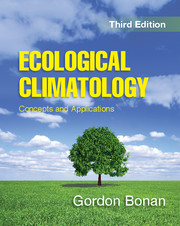Book contents
- Frontmatter
- Dedication
- Contents
- Preface
- 1 Ecosystems and Climate
- Part I The Earth System
- Part II Global Physical Climatology
- Part III Hydrometeorology
- Part IV Biometeorology
- Part V Terrestrial Plant Ecology
- 18 Plant Strategies
- 19 Populations and Communities
- 20 Ecosystems
- 21 Soil Biogeochemistry
- 22 Vegetation Dynamics
- 23 Landscapes and Disturbances
- 24 Global Biogeography
- Part VI Terrestrial Forcings and Feedbacks
- Appendix
- Index
- Plate section
- References
21 - Soil Biogeochemistry
from Part V - Terrestrial Plant Ecology
Published online by Cambridge University Press: 05 November 2015
- Frontmatter
- Dedication
- Contents
- Preface
- 1 Ecosystems and Climate
- Part I The Earth System
- Part II Global Physical Climatology
- Part III Hydrometeorology
- Part IV Biometeorology
- Part V Terrestrial Plant Ecology
- 18 Plant Strategies
- 19 Populations and Communities
- 20 Ecosystems
- 21 Soil Biogeochemistry
- 22 Vegetation Dynamics
- 23 Landscapes and Disturbances
- 24 Global Biogeography
- Part VI Terrestrial Forcings and Feedbacks
- Appendix
- Index
- Plate section
- References
Summary
Chapter Summary
Soils are the site of much geochemical and biological activity. Chemical weathering occurs when water, acids, and other substances react with minerals in rocks and soils. It occurs concurrent with physical weathering, which is the physical disintegration of rocks by various forces. Silicate clays and iron or aluminum oxide clays are the resistant end-products of chemical weathering. Chemical weathering releases elements into the soil solution for uptake by plants. In addition, the decomposition of plant detritus mineralizes nutrients for plant use. The rate of decomposition varies with temperature, soil water, and the chemical quality of litter. Various nitrogen trace gases diffuse out of soils during decomposition. The outcome of these processes is seen in the soil profile and its development over time. There are 12 broad classes of soil, known as soil orders, that vary in relation to degree of weathering, extent of soil development, climate, and associated vegetation. Parent material, time, topography, climate, and vegetation govern soil formation. Climate, particularly temperature and precipitation, determines the nature and rate of the weathering that occurs. Vegetation affects soil structure and fertility through the cycling of materials between plants and soil.
Weathering
The sand, silt, and clay particles that comprise mineral soil derive from physical and chemical weathering that breaks rocks into smaller and smaller fragments until individual minerals are exposed or new minerals are created. The mineralogical composition of rocks undergoes changes during weathering and is broadly grouped into primary and secondary minerals (Table 21.1). Primary minerals are resistant to weathering and change little in chemical composition during weathering. They are prominent in the sand and silt fractions of soil. Secondary minerals are products of the chemical breakdown or alteration of less resistant minerals. Secondary minerals are small in size and dominate the clay fraction of soil. Silicate clays and iron and aluminum oxide clays are prominent secondary minerals.
Physical weathering is the physical disintegration of rocks. It occurs from the scouring of rocks by water, wind, or ice.
- Type
- Chapter
- Information
- Ecological ClimatologyConcepts and Applications, pp. 358 - 375Publisher: Cambridge University PressPrint publication year: 2015



